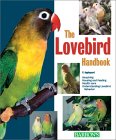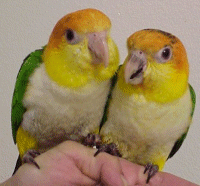Unseen Dangers in the Home
We have previously discussed dangers such as nonstick cookware, zinc, junkfood, andhazardous toys and household items. One of the more critical concerns in a bird household is the presence of deadly fumes. Many fumes that would not be hazardous to humans and other pets, such as cats and dogs, can kill a bird in a few minutes. Most of these problem fumes have been discovered the “hard way.” In other words, a person used one of these items then their bird died a few minutes after exposure. In some cases, a necropsy performed by a veterinarian confirmed damage to the lungs.
Hidden nonstick surfaces are a major concern. Many newer appliances, such as ovens and space heaters, contain nonstick surfaces. Obviously, a space heater can reach extremely high temperatures, possibly releasing PTFE fumes that have been proven deadly to birds. Many manufacturers are unaware of this danger or do not have documentation on their products to warn you about the presence of Teflon or other nonstick surfaces. If you are in doubt, do not use these items in rooms with birds. If you are worried that your house tends to be cold in the winter and you are using these heaters to warm your birds, this is most likely completely unnecessary. I know breeders of macaws who live close to the mountains in Southern California. They say the birds thrive even at temperatures near freezing. As long as the birds are not wet or near drafts, they will do fine.
| What is a draft? A draft is different from just cold air. You could think of it as a “thread” of cool air. It cuts a path of sorts through warmer air. This is what is hard on birds. Their body has adjusted to the room’s temperature, but they end up in the path of one of these threads of significantly colder air. If your bird is near a window, that window should be well insulated. To check it, hold your hand around the edges of the glass to feel for any “threads” of cooler air. Do this a number of times, particularly when it is windy outside, to make sure you haven’t missed a drafty spot. |
Another hidden source of nonstick material are cooking bags. There have been a number of reported incidents with these bags. They reach extremely high temperatures. Manufacturers often will not reveal the makeup of these bags, claiming it is proprietary information. I personally do not use these bags. If you feel you must, temporarily remove birds from the immediate area and put them in a room that does not share vents with the kitchen.
Scented items that release fumes should not be used around your birds. If you must burn scented candles, remove birds from the immediate area. Most of these items contain essential oils, which are hazardous when burned. There has been some evidence that they are not particularly good for human lungs as well, but we have much larger lungs that are constructed differently from bird lungs, so we can tolerate years of exposure. Birds can succumb upon a single exposure if they are in a confined space where they cannot escape the fumes.
This brings us to such “holistic health” items as tea tree oil. Many humans like to add tea tree oil or other similar products to the water of humidifiers. Do not do this if there is a bird sharing the same room. Tea tree oil fumes are particularly hazardous to birds.
Other items that have reportedly caused problems are scented sprays, plug-in air cleaners, leather protectant sprays, and other strong (particularly aerosolized) chemicals. This includes residual fumes from newly installed carpets, glue guns, or any type of significant constuction or repairs being done on your home where glues or other toxic substances might be used. I know a case of a woman who was having her central air conditioning unit replaced. She came home to find a house full of dead birds. They never narrowed down the exact cause, but it seems something was used during these repairs that went through the ventilation system and killed all the birds that were kept indoors.
I could list many other hazardous items here, but rather than miss a few and leave the impression they might be safe, I would rather give you my general rule: any item that releases strong fumes to scent or “clean” a room should not be used while a bird is in the airspace. Put the bird in another room until you are sure the fumes have dissipated. Open the window to the room before returning your bird to his or her cage so it can be well ventilated and free of residual chemicals. Common sense is the best approach: if in doubt about an item, put your birds someplace safe where they won’t be exposed to the fumes.










